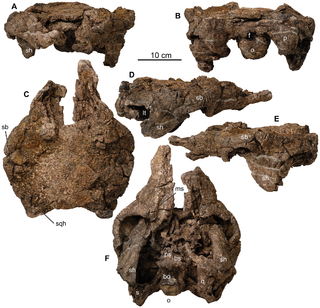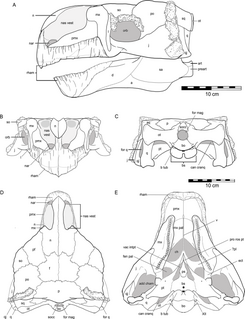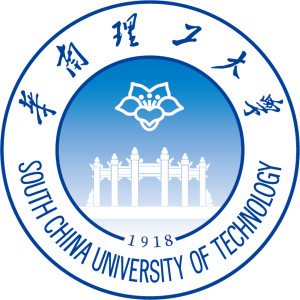
The Geoemydidae are one of the largest and most diverse families in the order Testudines (turtles), with about 70 species. The family includes the Eurasian pond and river turtles and Neotropical wood turtles.

The kaluga is a large predatory sturgeon found in the Amur River basin. Also known as the river beluga, they are claimed to be the largest freshwater fish in the world, with a maximum size of at least 1,000 kg (2,205 lb) and 5.6 m (18.6 ft). The kaluga is one of the biggest of the sturgeon family. Like the slightly larger beluga, it spends part of its life in salt water. Unlike the beluga, this fish has 5 major rows of dermal scutes, nail-like teeth in its jaws, and feeds on salmon and other fish in the Amur. They have gray-green to black backs with a yellowish green-white underbelly.

Siebenrockiella leytensis is a species of freshwater turtle endemic to the Philippines. It is classified as critically endangered. It is known as the Philippine forest turtle, the Philippine pond turtle, the Palawan turtle, or the Leyte pond turtle. Despite the latter common name, it does not occur in the island of Leyte but is instead native to the Palawan island group.

Scelidosaurus is a genus of herbivorous armoured ornithischian dinosaur from the Jurassic of England.

The seven-banded, long-nosed armadillo or just seven-banded armadillo, Dasypus septemcinctus, is a species of armadillo from South America found in Paraguay, Argentina, Bolivia and Brazil.
It is a solitary nocturnal, terrestrial animal, living mostly in dry habitats, outside of rainforest regions.

The Chinese box turtle, also known as the Yellow-margined box turtle, or Golden-headed turtle, is a species of Asian box turtle. Taxonomically, it has been called Cistoclemmys flavomarginata, Cuora flavomarginata, and Cyclemys flavomarginata. The Integrated Taxonomic Information System uses Cuora flavomarginata.

Reptile skin is covered with scutes or scales which, along with many other characteristics, distinguish reptiles from animals of other classes. Scales are made of alpha and beta-keratin and are formed from the epidermis. They may be ossified or tubercular, as in the case of lizards, or modified elaborately, as in the case of snakes.

Cuora cyclornata, the Vietnamese three-striped box turtle, also known as the green rice turtle in China, is a species of the Southeast Asian genus Cuora. It is distributed from the extreme southern part of the Chinese Guangxi Province southwards to central Vietnam and central Laos People's Democratic Republic. This species reaches up to 30 cm straight carapace length and is thus the largest Cuora species. Due to demand of traditional Chinese medicine, this species is nearly extinct in the wild, but is readily bred on Chinese turtle farms. Extremely high prices are paid for this species in China.
It can be distinguished from Cuora trifasciata by its larger size and generally more oval or rounder shell, which is usually also flatter, a white, pink, or orange chin, and head coloration with an orange-brownish-olive dorsal head pattern and less black pigment.

The turtle shell is a highly complicated shield for the ventral and dorsal parts of turtles, tortoises and terrapins, completely enclosing all the vital organs of the turtle and in some cases even the head. It is constructed of modified bony elements such as the ribs, parts of the pelvis and other bones found in most reptiles. The bone of the shell consists of both skeletal and dermal bone, showing that the complete enclosure of the shell probably evolved by including dermal armor into the rib cage.

Cyclemys is a genus of freshwater turtles, commonly referred to as Asian leaf turtles, from the family Geoemydidae. The genus occurs throughout Southeast and South Asia, and currently contains seven species.
Kayentasuchus is a genus of sphenosuchian, a type of basal crocodylomorph, the clade that comprises the crocodilians and their closest kin. It is known from a single skeleton found in rocks of the Sinemurian-Pliensbachian-age Lower Jurassic Kayenta Formation, northeastern Arizona.

He Jingtang is a prominent Chinese architect and the head of the architecture program at the South China University of Technology's school of architecture whose works include the wrestling and badminton venues built for the 2008 Beijing Olympics and the Chinese Pavilion sometimes referred to as the "Crown of China" for Expo 2010 which was held in Shanghai and later reopened as the China Art Museum. More recently designed the new campus of the University of Macau which was completed in 2013.
Redondasuchus is an extinct genus of aetosaur. It may a junior synonym of Typothorax coccinarum, another aetosaur. Redondasuchus is a member of the clade Typothoracisinae within the subfamily Aetosaurinae, and lived during the middle Norian stage of the Late Triassic. Material belonging to the genus has been found from the Redonda Formation in east-central New Mexico. The type species, R. reseri, was named in 1991 after having been referred to as a species of Typothorax since 1985. A second species, R. rineharti, was described in 2006.
Sierritasuchus is an extinct genus of aetosaur in the subfamily Desmatosuchinae. It is known from a small holotype skeleton from the Late Triassic Tecovas Formation of Texas. This skeleton was discovered in 1939 and was originally assigned to the genus Desmatosuchus. It was placed in its own genus in 2008 after having been in the collections of the University of Michigan Museum of Paleontology, with the type species being S. macalpini. The generic name refers to Sierrita de la Cruz Creek where the holotype was found, and the specific name refers to Archie MacAlpin, who discovered the skeleton. Based on the histology of the scutes of the holotype, the individual was a subadult that was not fully grown.

Dromotectum is an extinct genus of bystrowianid reptiliomorph from the Late Permian of China and Early Triassic of Russia. Two species have been named: the type species D. spinosum and the species D. largum. D. spinosum, the first species to be named, comes from Lower Triassic deposits in the Samara Region of European Russia and is known from the holotype PIN 2424/23, which consists of armor scutes, and from PIN 2424/65, 4495/14 and 2252/397. It was found in the Staritskaya Formation of the Rybinskin Horizon and named by I.V. Novikov and M.A. Shishkin in 2000. The generic name means “corridor with hipped vault” + “roof” (tecton), and the specific name means “spinous”. A second species, D. largum, was named by Liu Jun, Xu Li, Jia Song-Hai, Pu Han-Yong, and Liu Xiao-Ling in 2014 from the Shangshihezi Formation near Jiyuan in Henan province, China on the basis of specimen IVPP V 4013.1, a large scute.
SCUT UAV is a Chinese UAV developed by South China University of Technology (SCUT) for China Marine Surveillance (CMS). Although CMS has been operating UAVs, it actually never owned any, because UAV operations are contracted out to private companies and both the crews and UAVs are owned by private contractors. SCUT has developed an unmanned helicopter for CMS under the leadership of the general designer Professor Pei Hailong, the deputy director of School of Automation Science and Engineering of SCUT, and after its successful completion, the unmanned helicopter was handed over to CMS Guangdong division on December 30, 2011. The handed over ceremony marked the beginning of the first CMS UAV in Guangdong, as well as in China, because it is the first UAV owned and operated by CMS itself, instead of by private contractors previously. The complete name for the SCUT UAV by CMS is Marine Surveillance Unmanned Helicopter .
Specification:

Struthiosaurinae is a subfamily of ankylosaurian dinosaurs from the Cretaceous of Europe. It is defined as "the most inclusive clade containing Europelta but not Cedarpelta, Peloroplites, Sauropelta or Edmontonia" while being reinstated for a newly recognized clade of basal nodosaurids. Struthiosaurinae appeared at about exactly the same time as the North American subfamily Nodosaurinae. Struthiosaurines range all across the Cretaceous, the oldest genus being Europelta at an age of 112 Ma and the youngest being Struthiosaurus at about 85–66 Ma.

Kunbarrasaurus is a genus of small herbivorous ankylosaurian dinosaur from the Cretaceous of Australia.















